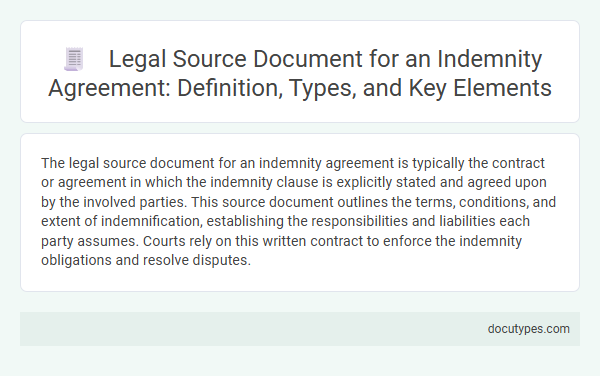The legal source document for an indemnity agreement is typically the contract or agreement in which the indemnity clause is explicitly stated and agreed upon by the involved parties. This source document outlines the terms, conditions, and extent of indemnification, establishing the responsibilities and liabilities each party assumes. Courts rely on this written contract to enforce the indemnity obligations and resolve disputes.
Introduction to Legal Source Documents for Indemnity Agreements
The legal source document for an indemnity agreement is typically a written contract that outlines the terms and obligations of the parties involved. It serves as the foundational evidence for enforcing indemnity provisions and protecting against potential losses. Understanding this document is essential to ensure your rights and responsibilities are clearly defined and legally binding.
Definition of Indemnity Agreement
| Term | Definition |
|---|---|
| Indemnity Agreement | A legal contract in which one party agrees to compensate another party for any losses, damages, or liabilities incurred. This agreement outlines the conditions under which indemnification will take place, protecting the indemnitee from potential financial harm. |
| Legal Source Document | The primary document that establishes the terms and conditions of the indemnity arrangement. It serves as the formal written contract specifying the obligations and rights related to indemnification between the parties involved. |
| Key Elements | Includes identification of parties, scope of indemnity, types of losses covered, duration, dispute resolution, and any limitations or exclusions. These elements ensure clear understanding and enforcement of the indemnity obligations. |
| Purpose | To allocate risk between parties and provide financial protection against claims or damages that may arise during the execution of a contract or business activity. |
Purpose and Importance of Indemnity Agreements
What is the legal source document for an indemnity agreement? The legal source document is the indemnity contract itself, which outlines the terms and conditions under which one party agrees to compensate another for potential losses or damages. This document serves as a binding legal instrument that defines the scope and obligation of indemnification.
Why are indemnity agreements important? Indemnity agreements protect parties from financial liability by transferring risk and ensuring compensation in case of claims or damages. Understanding this can help you safeguard your interests and manage potential legal and financial exposure effectively.
Types of Indemnity Agreements
An indemnity agreement legally binds one party to compensate another for certain damages or losses. The legal source document for an indemnity agreement outlines the specific terms and conditions that govern this obligation.
- Contractual Indemnity Agreement - This type is embedded within contracts to allocate risk and responsibility between parties.
- Statutory Indemnity - Established by law, these agreements arise from regulations requiring compensation under specific circumstances.
- Third-Party Indemnity Agreement - This type protects a party against claims or losses brought by a third party not directly involved in the contract.
Key Legal Elements of an Indemnity Agreement
The legal source document for an indemnity agreement is the indemnity contract itself, which outlines the obligations and protections between parties. This document is essential to define the scope of liability and responsibility for potential losses or damages.
Key legal elements include clear identification of the parties involved, specific indemnity clauses detailing the extent of coverage, and conditions under which indemnification applies. Your agreement should also address limitations of liability, notice requirements, and dispute resolution to ensure enforceability.
Essential Clauses in Indemnity Contracts
The legal source document for an indemnity agreement is a written contract that outlines the terms and conditions under which one party agrees to compensate the other for specific losses or damages. Essential clauses in indemnity contracts include the indemnity obligation, detailing the scope and extent of liability coverage, the definition of indemnifiable events, specifying situations that trigger indemnity, and limitations on liability to protect against excessive claims. Clear assignment of responsibilities and dispute resolution mechanisms are also critical to ensure enforceability and clarity in the agreement.
Parties Involved in Indemnity Agreements
The legal source document for an indemnity agreement is the indemnity contract itself, which outlines the obligations and protections agreed upon by the involved parties. This document serves as the primary reference for enforcing indemnity claims and defenses under applicable law.
Parties involved in indemnity agreements typically include the indemnitor, who agrees to compensate for any loss or damage, and the indemnitee, who receives the protection or compensation. These roles must be clearly defined within the agreement to establish rights and responsibilities. Identifying the parties accurately ensures that the indemnity provisions are legally enforceable and minimizes disputes.
Legal Requirements for Enforceable Indemnity Documents
The legal source document for an indemnity agreement is typically a written contract outlining the obligations and scope of indemnification between parties. This foundational document ensures clarity on the rights and responsibilities involved in risk allocation.
Enforceable indemnity agreements must meet specific legal requirements, including clear and unequivocal language defining the indemnitor's obligations. Compliance with jurisdictional contract laws, such as proper consideration and mutual consent, is essential to uphold the document's validity in court.
Common Risks Addressed by Indemnity Agreements
The legal source document for an indemnity agreement outlines the responsibilities and protections between parties concerning potential losses or damages. This document serves as the foundational contract that defines the scope and terms of indemnification.
- Liability for Property Damage - Covers compensation for physical damage to property caused during business activities or transactions.
- Personal Injury Claims - Protects one party against legal claims arising from bodily injuries sustained by individuals involved.
- Breach of Contract Risks - Addresses potential financial losses resulting from one party failing to fulfill contractual obligations.
Understanding these common risks helps clarify the importance of the legal source document in indemnity agreements.
What Is the Legal Source Document for an Indemnity Agreement? Infographic

